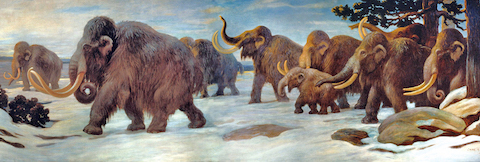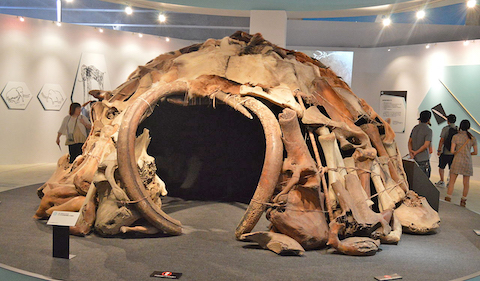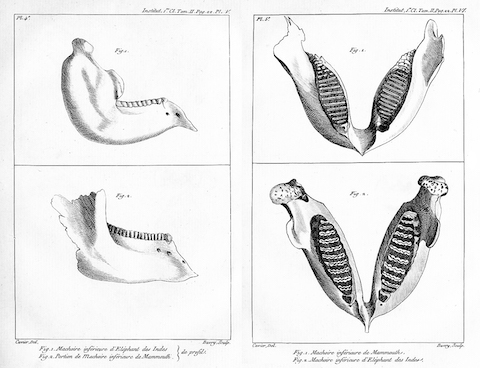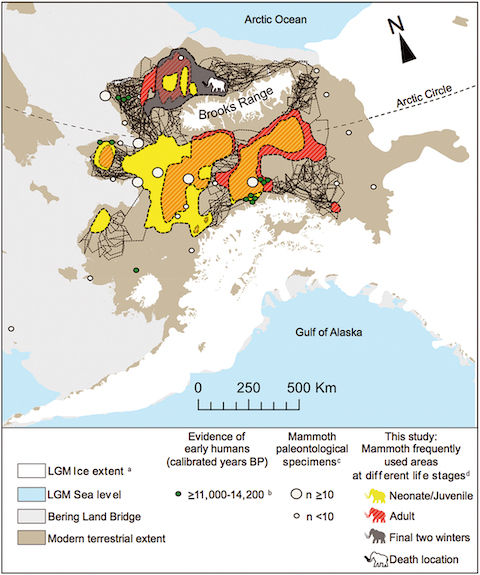
Wooly mammoths lived in Siberia and North America from about 5 million to as recently as 4,000 years ago.
They stood the same height as African elephants, up to 11 feet at the shoulder, but with long shaggy coats and much longer tusks.
Within one of those tusks, scientists found a remarkable story.
Mammoth tusks were just specially developed teeth, which grew new layers every year, from the inside.
Recently, scientists measured strontium in each layer of a tusk from one mammoth found in Alaska. All land animals ingest tiny amounts of strontium in food and water over their lifetime.
The researchers then matched the strontium signatures in each tusk layer to the strontium found in rodent teeth in different parts of Alaska. They could use this technique to map the lifetime travels of that one mammoth.
He was born 17,000 years ago in the Lower Yukon River Basin and lived there for the first year of his life.
From age 2, he roamed between two mountain ranges, likely with his herd, until he reached maturity at 16.
As a solitary adult bull, he covered an even larger area, traveling hundreds of miles, probably to stay in good grazing.
At age 28, he kept to a much smaller circuit, perhaps because of disease or injury, until he died, seemingly of starvation.
Little did he know, the tusks he left behind would tell his story.
Background
Synopsis: Just over 17,000 years ago, a young woolly mammoth lived and died in the Pleistocene grasslands of Alaska. Scientists have decoded chemical signatures in layers from his tusks that reveal the story of his birth, his life travelling around most of what we now call Alaska, and his death.
- The woolly mammoth (Mammuthus primigenius) is one of the best studied prehistoric animals on Earth.
- The discovery of skeletons, teeth and frozen carcasses in Alaska and Siberia, with preserved skin, hair, stomach contents and dung, provide unprecedented detail about these extinct megaherbivores.
- Prehistoric cave paintings further illustrate their appearance, behavior and relationship to early humans who lived alongside them. Their tusks and bones were used for prehistoric art, tools and huts.

This museum replica of a prehistoric mammoth tusk and bone dwelling discovered in the Ukraine was created from actual mammoth fossils. Credit: Nandaro, https://creativecommons.org/licenses/by-sa/3.0, via Wikimedia Commons
- Mammoths first evolved nearly 5 million years ago in the early Pliocene Epoch in Africa from the ancestors of both mammoths and elephants.
- Woolly mammoths diverged from other types of mammoths in the Pleistocene Epoch about 400,000 years ago in Siberia, crossing the Bering Strait into North America about 100,000 years ago.

Two plates from Cuvier’s 1798–99 paper on living and fossil elephants comparing the lower jaw of an Indian elephant (top left and bottom right) to the fossil lower jaw of a woolly mammoth (bottom left and top right). Credit: Georges Cuvier (1769–1832), via Wikimedia Commons - Georges Cuvier identified them as an extinct species related to elephants in 1796. In 2015, a genome project confirmed Cuvier’s 219-year-old idea that their closest modern relative is the Asian elephant.
- Woolly mammoths diverged from other types of mammoths in the Pleistocene Epoch about 400,000 years ago in Siberia, crossing the Bering Strait into North America about 100,000 years ago.
- Woolly mammoths were about the same size as today’s African elephants with adults ranging from 8.5 to 11 ft (2.6–3.4 m) tall and were well adapted to the Pleistocene cold.
- These megaherbivores were covered in a fur undercoat with coarse guard hairs ranging from 6 to 36 in (15–90 cm) in length all over their bodies.
- Their skin was about the same thickness as that of elephants, but they had a 4 in (10 cm) layer of fat to keep them warm.
- Their ears and tail were small, minimizing heat loss and frostbite.
- They had four molars and modified incisors that spiraled into distinctive curved tusks that were about 30% longer than those of modern elephants.
- They ate grasses and sedges in steppe habitats and lived for about 60 years.
- The furthest extent of ice sheets and the coldest temperatures during the most recent Pleistocene glaciation occurred about 25,000–20,000 years ago.
- This Last Glacial Maximum was followed by deglaciation characterized by a warming climate and rising sea levels.
- Around 17,000 years ago, a young woolly mammoth lived and died in the Pleistocene grasslands of Alaska. Scientists have now decoded chemical signatures in his tusks that reveal the story of his 28-year life and his death.
- Mammoth tusks grew 1 to 6 in (2.5–15 cm) per year by adding new cone shaped layers at the base from the age of about a year old.
- The longest known woolly mammoth tusk is 14 ft (4.25 m) long.
- The tusks grew in a conical pattern with the oldest layers at the tips, creating a chemical chronicle of the mammoth’s entire life, like tree rings.
- About 25% of the tusk remained inside the sockets, with the external tusks curving toward each other close to the skull to mitigate the twisting force (torque) from their heavy weight.
- Researchers located a 5.6 ft (1.7 m) tusk that was part of a pair found with a lower jawbone and other skull fragments for their study.
- Genetic analysis showed it was a male mammoth.
- They used a laser to take more than 340,000 samples, measuring ratios of various isotopes of strontium, a soft, metallic element of the alkaline-earth group that is interchangeable with calcium in chemical reactions, incorporated into the tusks from the food and water the mammoth consumed through its lifetime.
- Ratios of the four stable isotopes of strontium are very sensitive to geological and environmental variation so, along with ratios of oxygen isotopes, they serve as fingerprints for specific geographical areas.

A closeup of a split mammoth tusk is stained blue to reveal growth layers added to the tusk like adding a new cone into the base of a stack of ice cream cones. Sampling locations for isotope analysis are visible along the middle of the tusk. Sampling along the entire tusk in this manner provides a record of the mammoth’s entire life. Credit: JR Ancheta, University of Alaska Fairbanks - Since the Pleistocene, the Alaskan landscape has not changed much, so modern isotopic ratios from the teeth of rodents were used to characterize regions where the mammoth roamed thousands of years earlier and then matched to the findings from the tusk.
- While fossils can tell us that extinct animals existed, these innovative chemical methods can tell us about how these extinct animals lived—scientists mapped out the mammoth’s birthplace, herd interactions and range, adult wanderings and determined its cause of death from their isotopic analyses.
- The first 4 in (10 cm) of the tusk reveal that the mammoth was born in the Lower Yukon River Basin and spent the first year of his life there.
- The next 30 in (75 cm) of tusk show that from age 2 to adolescence at age 16 he roamed a larger range between the Brooks and Alaska Ranges, probably with his herd.
- The next section of tusk shows him expanding northward into a much larger region including the Brooks Range, likely as a solitary adult bull after expulsion from the herd. He sometimes covered more than 300 mi (500 km) in a few months, suggesting he needed an extended habitat for grazing.
- Finally, he wandered in a much smaller area before his death at 28, which is about half the normal life span for mammoths. Carbon- and nitrogen-isotopic signatures suggest he may have starved to death, but it is not clear why.

The modeled range of the woolly mammoth, based on isotope data. Credit: Wooller et al., Science, 2021
- The woolly mammoth disappeared from mainland Eurasia and North America in the early Holocene, around 10,000 years ago.
- A changing climate is thought to have caused boreal forests to replace the continental, grassy mammoth steppe habitat while rising seas drowned the coastal grasslands of Beringia, the ice age land bridge between Siberia and Alaska.
- Human predation may have also played a part in their extinction.
- As sea level rose, small populations of woolly mammoths survived on two arctic islands for a few thousand more years, with extinction occurring on St. Paul Island about 5,600 years ago and on Wrangel Island about 4,000 years ago.
- Humans still use fossil mammoth ivory for art.

